Did you know that creativity is one of the 10 life skills the World Health Organization suggests1? This shows how important artistic expression and creative activities are for us. I’ve explored creativity and found out how it helps our minds and makes us feel better.
Creativity isn’t just for famous artists or inventors. It’s a key part of being human that shows up in many ways. From drawing and dancing to cooking and gardening, these activities let us express ourselves1. They can make us less stressed, help us solve problems better, and make us emotionally stronger2.
Artistic expression does more than just help our mental health. It can make our immune system stronger, improve our thinking skills, and help with pain2. It’s amazing how simple things like drawing or playing music can have such big effects on us.
The healing power of creative arts isn’t new. In ancient India, dance was seen as a way to ease stress and bad feelings. The Natya Shastra, an old text, talks about how creative arts can help manage feelings and improve well-being1. This shows how creativity has been seen as important for a long time.
Key Takeaways
- Creativity is recognized as a crucial life skill by the WHO
- Artistic expression encompasses a wide range of activities
- Creative pursuits can reduce stress and enhance problem-solving skills
- Engaging in art can boost immune function and cognitive abilities
- The therapeutic power of creativity has roots in ancient traditions
- Artistic activities can induce a state of flow, improving mood and well-being
Understanding Creativity and Its Importance
Creativity is more than just making art. It’s about coming up with new ideas that change our lives and ourselves. Today, it touches on everything from art to solving everyday problems.
Defining Creativity in Modern Context
Creativity isn’t just for artists anymore. It’s key in our fast-moving world. Research shows that being creative can make us less stressed and lower our blood pressure3. This is true for all kinds of art, like painting or dancing.
The Four-C Model of Creativity
The Four-C model gives us a full picture of creativity:
| Level | Description | Example |
|---|---|---|
| Mini-c | Personal insights and learning | A child’s first drawing |
| Little-c | Everyday problem-solving | Finding a new route to work |
| Pro-C | Professional-level creativity | A chef creating a new recipe |
| Big-C | Groundbreaking achievements | Einstein’s theory of relativity |
Creativity as a Life Skill
Creativity is crucial for growing personally and succeeding in your career. It helps us solve problems, boosts our confidence, and makes us feel like we belong4. It drives innovation in many areas, leading to new ideas and solutions3. By being creative every day, we can better appreciate beauty and improve our well-being.
“Creativity is intelligence having fun.” – Albert Einstein
Doing creative things, like making art or performing, releases happy chemicals in our brains. This can make us feel better and help with anxiety and depression3. So, adding creativity to our lives is good for our mental and brain health.
The Historical Perspective of Art and Well-being
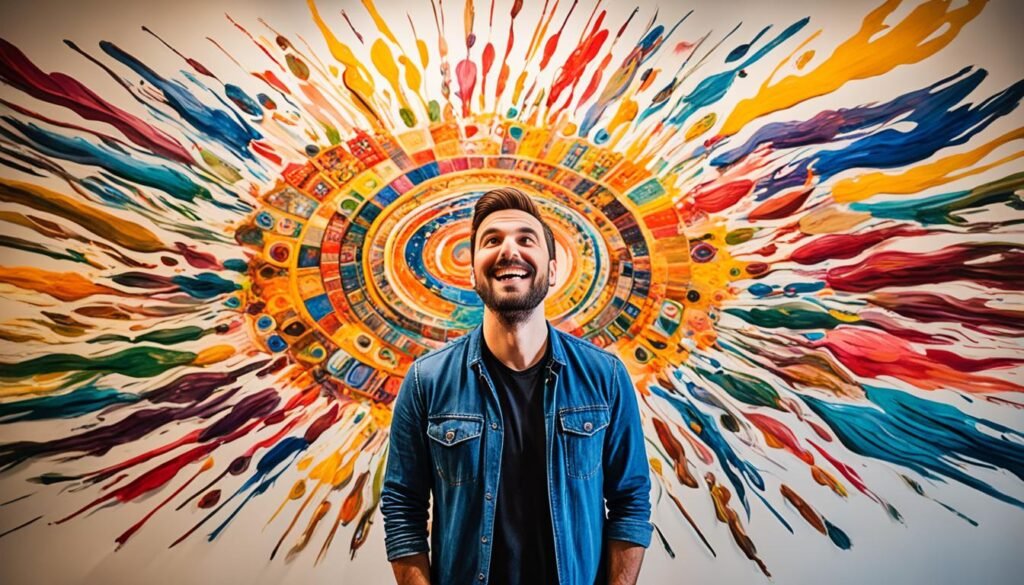
Art has always been a key part of our culture and a way to express feelings. It goes way back to ancient times. In India, art was made to help people feel better and deal with tough emotions. This shows how art was seen as a way to heal.
The Natyashastra, an old Indian book, tells us how dance was made by Brahma to help with pain. This idea of art helping us feel better has been around for a long time. Then, in the mid-1900s, art therapy started in Europe. Adrian Hill, a British artist, came up with the term “art therapy” in 19425.
As art therapy grew, groups were formed to help it grow and be recognized. The British Association of Art Therapists started in 1964, and the American Art Therapy Association followed in 19695. These groups were key in making art therapy a known treatment.
Now, art is used to help with many health issues. It’s good for people with mental health problems, anxiety, depression, and even physical issues like cancer and stroke6. Studies show that making or looking at art can make you feel better by raising serotonin levels and improving blood flow to the brain’s happy center6.
Looking at art’s history, we see how it has always been a powerful way to heal and grow. It shows us the lasting impact of art on our well-being.
Neuroscience Behind Artistic Expression
The world of art and creativity has always fascinated both scientists and artists. By looking into the neuroscience of art, we see how our brains interact with and make art.
Brain Plasticity and Creative Activities
Being creative changes our brains in special ways. Art acts as a way to share culture and feelings7. When we look at or make art, our brains change a lot. Research shows art can lower blood pressure, boost the immune system, and reduce stress8.
Cognitive Functions Enhanced by Art
Learning about art makes students more engaged and improves their grades9. Even simple tasks like doodling or knitting can help us learn better than just listening8. This shows how artistic techniques boost our thinking skills.
Neurochemical Changes During Creative Processes
Creating art changes our brains in big ways. It makes us feel happy and fulfilled by releasing dopamine9. This is why art is often an emotional way to express ourselves, bringing us joy and relief.
| Neurochemical | Effect | Artistic Activity |
|---|---|---|
| Dopamine | Pleasure and satisfaction | Creating or viewing art |
| Serotonin | Mood regulation | Engaging in repetitive art tasks |
| Oxytocin | Social bonding | Collaborative art projects |
Exploring art and the brain shows us art is more than just pretty. It helps our thinking, feelings, and overall health.
Artistic Expression and Mental Health
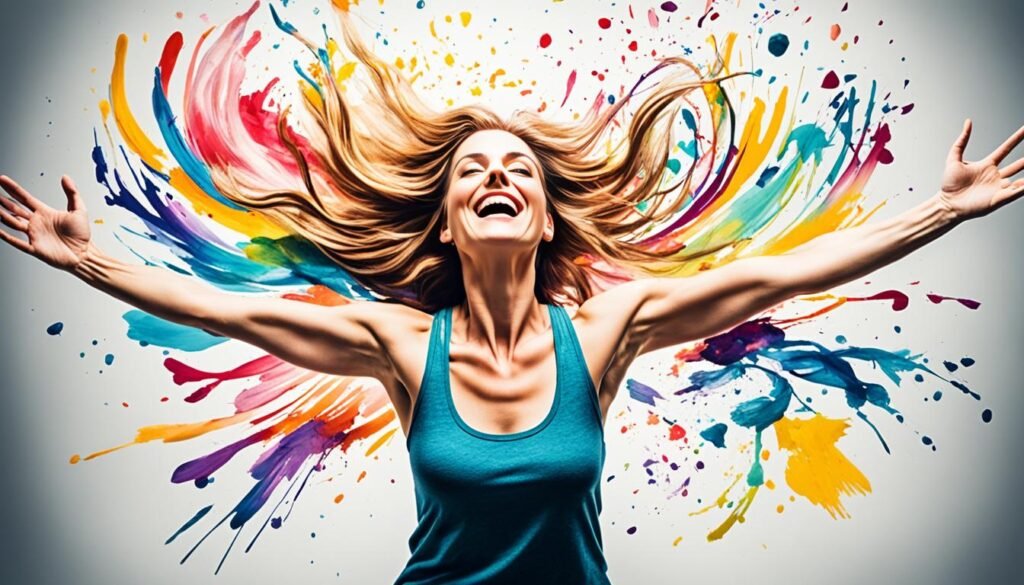
Art lets us express our feelings and thoughts in a powerful way. It helps our mental health a lot. Studies show that making art can make us feel less stressed, anxious, and depressed.
Just 20 minutes of art can lower stress hormones. Doing art for 45 minutes can make us feel proud and boost our self-esteem. This can make us feel better overall10.
Art comes in many forms, each with its own benefits. Drawing and painting can help reduce stress and improve memory. They are great for seniors and people with dementia. Singing can make us feel happy and bring people together. Dancing can lower anxiety and improve life quality, and it might even help prevent dementia in older people11.
Art therapy is a special kind of treatment for mental health issues. A review found that it helped cancer patients feel less anxious, depressed, and improved their life quality12.
“Art washes away from the soul the dust of everyday life.” – Pablo Picasso
Expressive arts therapy helps us deal with tough feelings and find comfort. One exercise is to make art about things we want to let go of, then destroy it in a creative way. This can be very healing10.
Adding art to our daily life can make us more creative and improve our mental health. Whether it’s painting, singing, or dancing, art is a special way to get better mentally.
The Role of Art in Emotional Regulation
Art is key in managing emotions, acting as a powerful way to express feelings. Studies now show how making art can boost our mental health.
Art as a Coping Mechanism
Art is a great way to deal with tough feelings. Researchers in London created the Emotion Regulation Strategies for Artistic Creative Activities Scale (ERS-ACA). This scale has three main parts: avoiding feelings, facing feelings, and growing personally13.
This scale came from a big study with almost 48,000 people. It shows how art helps us handle our feelings13.
Expressing Complex Emotions Through Creativity
Creative activities let us express hard feelings in a special way. Those who use art to avoid feelings say, “When I’m making art, I can block out any unwanted thoughts or feelings.”13 This is really helpful for people dealing with trauma or loss.
Building Emotional Resilience Through Art
Art can make us more emotionally strong. People who use art for personal growth tend to handle feelings better and think more positively, which is good for our mental health13. Research shows that group drumming can lower stress, sadness, and boost social strength in people using mental health services14.
| Art Form | Emotional Benefit |
|---|---|
| Gardening | Improved overall health |
| Group Singing | Enhanced mental wellbeing |
| Visual Arts | Potential for mental health recovery |
Art projects can move us from bad feelings to good ones, like from frustration to excitement or fear to courage15. Art acts as an Emotional Outlet, boosting brain function and helping us grow socially and emotionally. It builds confidence and strengthens our connections with ourselves and others15.
Creative Pursuits and Stress Reduction
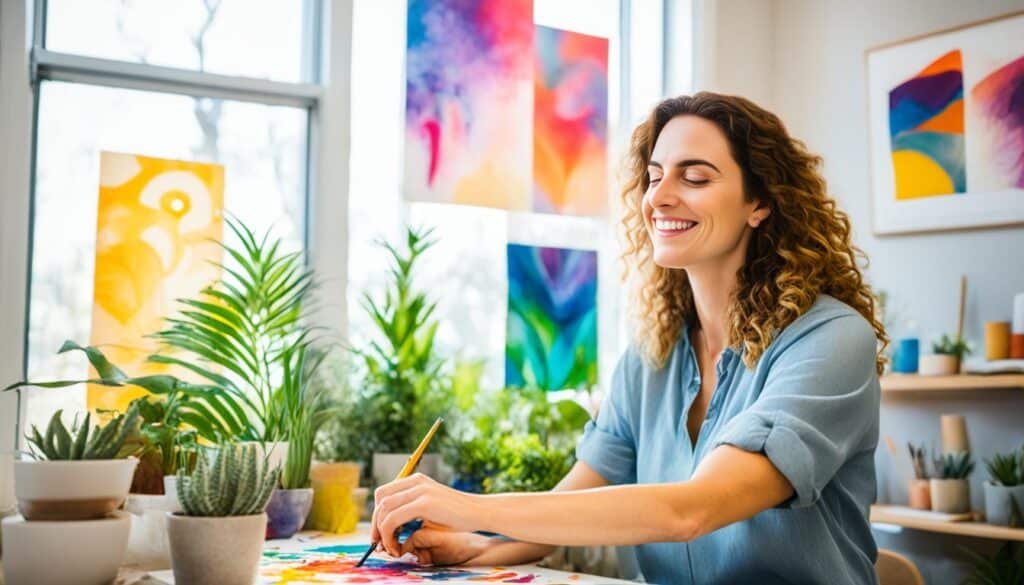
Art is a great way to express feelings and reduce stress. I’ve found that making art can lower stress by up to 75%16. This happens because art-making helps you focus on the moment, taking your mind off daily worries.
When I paint or draw, I get lost in the process. This flow state makes me feel fully engaged and time flies by. It also makes me feel better and more relaxed. Studies show that doing creative things can boost your mood and self-confidence by up to 60%16.
Creative activities aren’t just about art. Music therapy, like playing an instrument or singing, can cut anxiety by up to 45%16. Even hobbies like woodworking and metalwork can help manage stress by 25%16.
Art washes away from the soul the dust of everyday life. – Pablo Picasso
Art has a big impact on mental health. Over 100 studies have looked into how art affects health. They found it can lower anxiety, calm the mind, and offer a safe space for intense feelings17. Adding creativity to your life, even in small ways, can make you feel better without costing a lot17.
| Creative Activity | Stress Reduction Benefit |
|---|---|
| Visual Arts (Painting, Drawing) | 75% stress level reduction |
| Music Therapy | 45% anxiety symptom reduction |
| Woodworking/Metalwork | 25% improvement in stress management |
Enhancing Problem-Solving Skills Through Art
Art isn’t just for making beautiful things. It’s a great way to improve problem-solving skills. By using artistic techniques, we can think more creatively and find new solutions to problems.
Divergent Thinking in Artistic Processes
When I make art, I practice divergent thinking. This means I come up with lots of ideas, not just one. Studies show that art can make our brains work better together, helping us solve problems better18. This skill is useful everywhere, not just in art.
Applying Creative Problem-Solving to Daily Life
The skills from art help us in many ways. Art makes our brains work better in areas like memory, attention, and planning19. I’ve noticed that thinking like an artist makes solving problems at work and home easier.
Art as a Catalyst for Innovation
Art makes us think differently. It’s a way to enrich our culture and come up with new ideas. Research shows that the arts are good for our mental health and make our brains work better18. Being flexible in our thinking is key to coming up with new ideas.
| Skill Developed | Artistic Activity | Real-Life Application |
|---|---|---|
| Divergent Thinking | Brainstorming color schemes | Generating multiple solutions to a work problem |
| Attention to Detail | Sculpting or painting | Noticing small but important aspects in daily tasks |
| Creative Problem-Solving | Mixed media projects | Finding unique approaches to household issues |
Studies show that kids who learn art do better in science and math. This shows how creativity and art help us think logically and solve problems20. By using art, we can get better at solving problems and be more innovative in life.
The Impact of Artistic Expression on Self-esteem
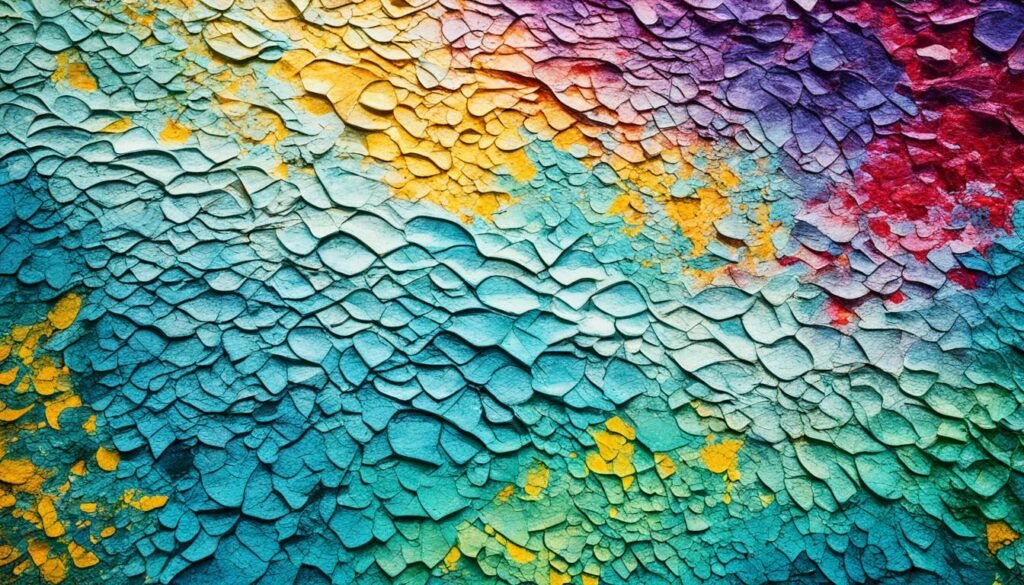
Artistic expression is key to boosting our self-esteem. When we create, we feel a deep sense of achievement and purpose. Setting and reaching creative goals helps us grow new skills and talents, making us feel more valuable.
Art lets us express ourselves and work through tough feelings21. This creative journey changes us, making us grow personally. Studies show that art can cut anxiety and stress by 55%22.
Creative activities help us discover ourselves and explore our feelings. Research shows that kids who do arts have more self-esteem. Adults also benefit, finding art boosts their confidence and self-worth.
Artistic self-expression has many benefits:
- Boosts mental health and self-esteem21
- Improves problem-solving and thinking skills22
- Increases self-awareness and emotional smarts22
- Makes us more mindful and present in everyday life22
By diving into art, we open up to self-discovery and growth. Creating lets us see our inner selves, share our views, and gain confidence. As we keep creating, we build our self-esteem and a stronger identity.
Art Therapy: A Clinical Perspective
Art therapy started as a clinical field in the 1940s and became well-known in the 1970s23. It’s a special way to help with mental health issues, showing good results for many conditions.
Principles of Art Therapy
Art therapy uses creativity to help people heal and feel better. Art therapists have advanced degrees and work with people in places like hospitals and schools24. This therapy uses art to change lives, helping both individuals and communities.
Applications in Mental Health Treatment
Art therapy helps with anxiety, depression, trauma, and feeling bad about oneself23. It’s great for people with serious illnesses, those learning to cope, and those in the hospital with pain23. Recent studies show it can help people with mental health issues, reducing their symptoms25.
Case Studies and Success Stories
Research on art therapy is encouraging. Of 413 studies on painting and drawing in therapy, 23 focused on mental health issues25. Kids often use art to express feelings, making it a key tool for understanding and helping them through tough times23.
But, it’s key to know that not everything called “art therapy” is real. Only trained professionals with the right credentials can truly offer this therapy24.
Fostering Creativity in Education
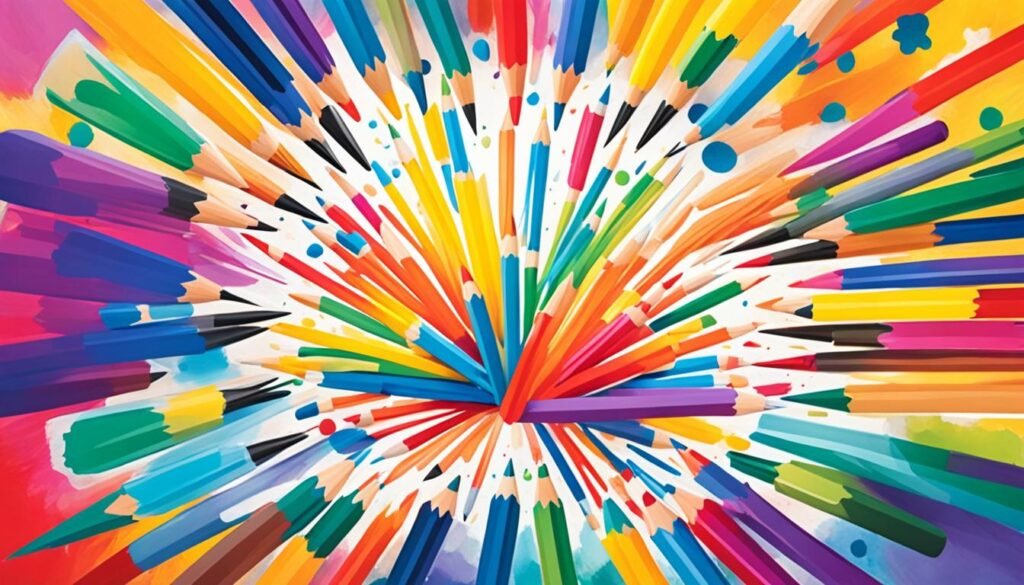
In today’s fast-changing world, making education creative is key. New industries pop up and disappear every decade, showing the need for creative thinking26. As an educator, I’ve seen how creativity leads to better teamwork, problem-solving, and new ways of learning26.
Artistic techniques are crucial for this. From the start, babies react to music and sounds, moving towards the tunes27. As they grow, they remember songs and move better27. These early moments set the stage for creativity.
In class, we can empower students through art education by making learning spaces flexible. This helps unlock creativity and makes learning better26. Open-ended tasks boost critical thinking and let students use their creativity26.
“Creativity is intelligence having fun.” – Albert Einstein
Working in groups is great for creativity. Teams usually come up with more innovative ideas than one person alone26. To boost creative thinking, I give feedback that shows students the worth of their ideas26.
Adding art to all subjects makes learning more fun. Babies show feelings with their faces and gestures27. Toddlers use materials to make art and play out real-life scenarios27.
| Age Group | Creative Development | Educational Approach |
|---|---|---|
| Young Infants | Respond to voices and music | Provide varied auditory stimuli |
| Mobile Infants | Explore materials for art | Offer safe, tactile art supplies |
| Toddlers | Create and describe art | Encourage artistic expression and discussion |
By using these methods and knowing about growth stages, we can make learning rich and creative. This prepares students for tomorrow’s challenges.
The Mind-Body Connection in Creative Pursuits
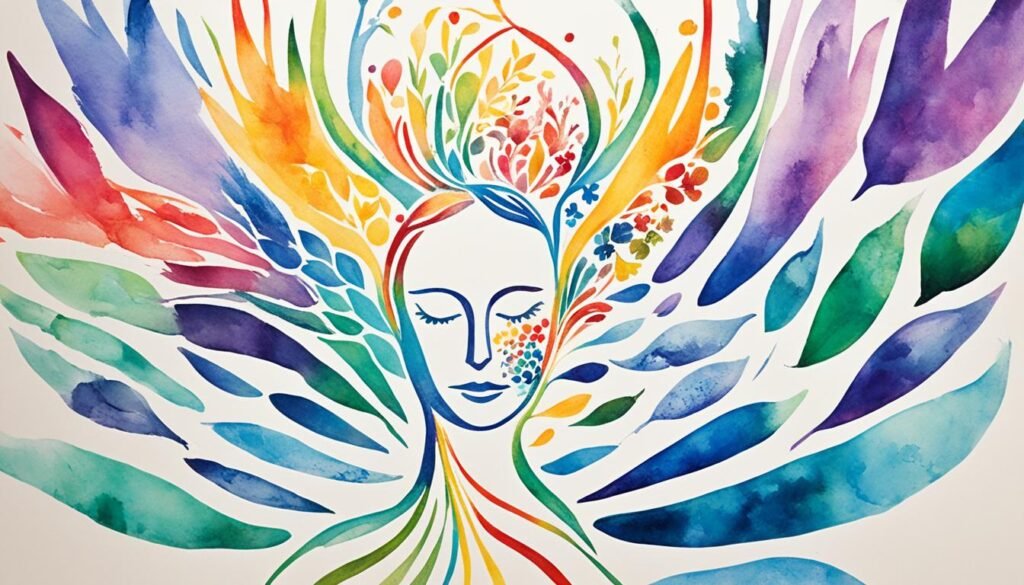
Creative activities do more than just challenge our minds. They connect our minds and bodies, promoting overall wellness. Art and beauty play key roles in this link, affecting our health in ways we might not expect.
Physical Health Benefits of Artistic Activities
Art can greatly improve our physical health. For example, making art for 45 minutes lowered stress hormones in 75% of adults28. This drop in stress hormones can lead to better heart health and a stronger immune system.
Music therapy, a form of art, has shown amazing results in hospitals. It lowered blood pressure and heart rate28. Even simple things like looking at nature pictures or a garden can help lower blood pressure and ease muscle tension28.
Art and Pain Management
Art is becoming more recognized for helping with pain. Patients in the hospital who listened to calming music after a heart attack saw their heart rate and breathing slow down, and their heart needed less oxygen28. This shows that art can be a powerful way to manage pain and aid in recovery
Creativity and Immune System Function
Creativity has a big impact on our immune system. Patients in the hospital who listened to Mozart’s music had more growth hormone and less interleukin-6, which is good for the heart28. These findings suggest that art can help boost our immune system.
| Creative Activity | Physical Health Benefit |
|---|---|
| Making Art | Reduced cortisol levels |
| Music Therapy | Lowered blood pressure and heart rate |
| Viewing Nature Photos | Decreased anxiety and pain medication needs |
| Listening to Mozart | Improved growth hormone and cardiac health |
By adding art to our daily lives, we can enjoy these physical health benefits. Whether it’s painting, listening to music, or enjoying nature, these activities offer a full approach to wellness. They go beyond what traditional medicine can do.
Artistic Expression and Cognitive Aging
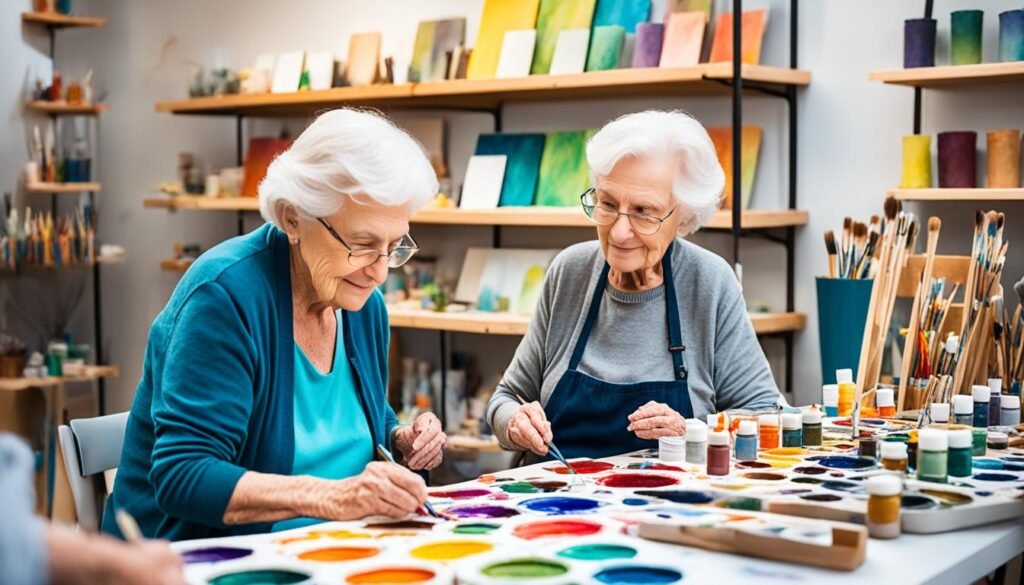
As more people get older, keeping our minds sharp is key. By 2030, over 20% of the U.S. will be over 65. This shows we need good ways to help older adults stay healthy29. Art and visual arts are great tools for this, offering more than just beauty.
Studies show that making art can really help older adults think better. A study found that those who enjoyed arts had a 31% lower risk of dying early30. This means art might help people live longer by keeping their minds sharp and boosting their mood and activity levels.
Visual arts like painting and sculpture can make older adults think better, feel less sad, and keep their brains active30. These activities need focus, decision-making, and problem-solving. This keeps the brain working well and might slow down aging-related brain decline.
Art isn’t just good for the mind. Making art with others can make people feel better about themselves, motivate them, and connect them with others29. This is important because many older adults feel lonely, which can lead to feeling sad and other health issues.
Art therapy has been around since the 1930s and helps with dementia, depression, and anxiety in older adults31. Being creative helps older people feel in control, happy, and keeps their brains flexible. It also helps them stay connected with others. These things are key to avoiding mental health problems like feeling alone and being treated unfairly31.
I urge older adults to try different types of art. Whether it’s painting, sculpture, or visiting art museums, adding these to their daily life can greatly improve their mental and overall health as they age.
Integrating Creative Activities into Daily Life
Adding creativity to our daily life can change how we feel. Studies show that making art can lessen depression and anxiety and make us happier32. It’s not about becoming a famous artist. It’s about enjoying making things and feeling better mentally.
Simple Creative Exercises for Beginners
Starting with art doesn’t have to be hard. A survey found that 75% of people enjoy making art every day33. You can try journaling, coloring, or use photography apps to be more creative33. These easy activities can help you find yourself and relax.
Creating a Creativity-Friendly Environment
Where we are affects our creativity. Online art sales have gone up by 30% for home décor items recently33. Having a space that sparks your creativity helps you be more creative. This could mean showing off your art or listening to classical music, which is getting more popular33.
Overcoming Creative Blocks
We all hit creative walls, but don’t give up. Art helps us deal with feelings and tough times32. If you’re stuck, try something new or take a class. Classes for art skills have seen a big increase in students, showing more people want to express themselves33. Remember, being creative is like a muscle – use it often, and it will get stronger.
FAQ
What are the cognitive benefits of artistic expression and creative pursuits?
Artistic activities boost brain function and improve memory and problem-solving. They help people with Alzheimer’s disease by making the brain more flexible.
How is creativity defined in a modern context?
Creativity means making something new that changes the world and us. It’s a mix of art, thinking, and feeling. The Four-C model explains creativity in different ways, showing its wide impact.
What is the historical perspective on art and well-being?
Long ago, art in India was for stress relief and calming negative feelings. The Natyashastra talks about dance’s creation to ease suffering. This shows art’s long role in emotional health.
How does artistic expression impact the brain and cognitive functions?
The creative process has many steps, each using different brain parts. It makes the brain more flexible and boosts skills like memory and problem-solving.
How can artistic expression benefit mental health?
Creative work helps process hard feelings and express oneself truly. It’s a strong way to deal with life’s stress. Art therapy uses art to explore feelings and thoughts, helping with mental health.
How can art help in emotional regulation?
Art lets people show feelings hard to say out loud. It’s great for those facing trauma or big life changes. Art helps put feelings outside, making them easier to handle, and builds emotional strength.
How can creative pursuits reduce stress?
Creative tasks like drawing or crafting are like meditation, taking focus off stress. They lead to a state of flow, where time seems to stop, reducing stress.
How can art enhance problem-solving skills?
Being creative boosts thinking outside the box and solving problems. Art makes you think differently, helping in life and leading to new ideas and growth.
How can artistic expression impact self-esteem?
Being creative brings a sense of achievement and boosts self-confidence. Setting and reaching creative goals grows skills and talents, making one feel more valuable.
What is art therapy, and how is it applied in mental health treatment?
Art therapy uses art to improve mental health. It helps with anxiety, depression, and more. It’s a safe way to express feelings, leading to healing and better well-being.
How can creativity be fostered in education?
Adding creativity to school makes learning fun and helps the brain grow. It improves problem-solving and lets students express themselves. Arts in school make learning engaging for everyone.
What are the physical health benefits of artistic activities?
Art is good for the body and mind. It lowers stress, relaxes, and boosts the immune system. Art therapy can help with pain, making it a holistic health tool.
How can artistic expression benefit cognitive aging?
Art keeps the brain sharp in older adults. It needs focus and problem-solving, keeping the mind active. Art also helps seniors connect with others and express feelings, improving their life quality.
How can creative activities be integrated into daily life?
Bring creativity into daily life with things like journaling or gardening. These activities offer relaxation and inspiration. Making a space for creativity and overcoming blocks helps keep a consistent practice for better mental health.
